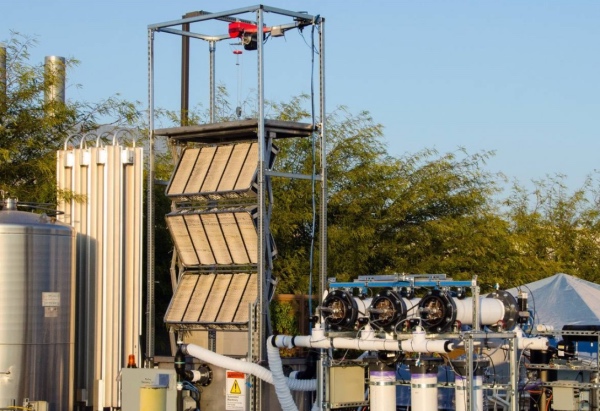New York City, US
Thomson Reuters Foundation
A Dublin-based company plans to erect “mechanical trees” in the United States that will suck carbon dioxide from the air, it said this week, in what may prove to be biggest effort to remove the gas blamed for climate change from the atmosphere.
The company, Silicon Kingdom Holdings, will build 1,200 carbon-cleansing metal columns within a year with which it hopes to capture CO2 more cheaply than other methods, following a successful test in Arizona over a two-year period, it said.

A prototype device of the “mechanical tree” is shown in the summer of 2018. PICTURE: Courtesy of the University of Arizona.
That is enough to suck up nearly 8,000 cars worth of emissions per year of CO2.
“We have to figure out how to act to get to a climate that is safe,” said the technology’s inventor, Klaus Lackner, a professor at Arizona State University.
SKH’s pilot would be the world’s largest “direct air capture” operation to date, said Jennifer Wilcox, a professor of chemical engineering at the US-based Worcester Polytechnic Institute, who is not involved in the project.
Carbon capture is gradually gaining momentum, with the United Nations saying in a report last year that the technology is likely needed to keep the rise in global temperatures below catastrophic levels.
SKH expects its two-year pilot, possibly in California, to capture about 36,500 metric tons of CO2 a year, it said – the equivalent of nearly 7,750 vehicles driven for a year.
Full-scale farms would be 100 times bigger.
The company’s “mechanical trees”, as the firm has dubbed them because they are tall and slender and absorb CO2 just like trees, are fitted with filter-like components to absorb the CO2, a photo of a prototype showed.
The device uses wind to blow air through its system rather than an energy-intensive mechanism, it said.
While capturing CO2 from industrial facilities and power plants has a decades-long commercial history, “direct air capture”, which pulls the gas directly from the atmosphere is a burgeoning field with only a handful of players, said Wilcox.
Swiss firm Climeworks has so far led the market, alongside Canada-based Carbon Engineering and US-based Global Thermostat, she said.
The companies compress the high-concentration CO2 they capture and can then sell it for use in industrial applications, including making drinks fizzy, creating fuel and extracting oil.
While the high price of direct air capture has long been viewed as an impediment to scaling up the technologies, SKH’s costs is less than $US100 per metric ton for pure CO2, it said.
“The $US100 a ton is important because I think that’s the point where things start to get economically interesting,” Lackner told the Thomson Reuters Foundation.
“You can buy liquid CO2 which is delivered by truck in order to fill fire extinguishers and myriad other things for prices between $US100 and $US200 a ton.”
SKH would not provide information about how much building the pilot would cost. It said it was “in discussions with a range of potential funders and strategic partners from the aviation, energy and food and beverage industries”.





